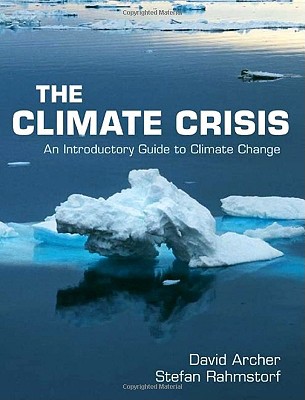

| THE CLIMATE CRISIS An Introductory Guide to Climate Change David Archer Stefan Rahmstorf Cambridge: Cambridge University Press, 2010 |
Rating: 5.0 High |
|||
| ISBN-13 978-0-521-73255-0 | ||||
| ISBN 0-521-73255-7 | 249pp. | SC/FCI | $39.99 | |
David Archer is professor of Geophysical Sciences at the University of Chicago. He has over 70 scientific papers and several books to his credit. Stefan Rahmstorf is professor of Physics of the Oceans at the Potsdam Institute for Climate Impact Research. He has published over 50 scientific papers and is co-author of two books, and was a lead writer of the Fourth Assessment Report from the IPCC. These two scientists are thus very credible on climatology, and they have produced a very creditable volume explaining the complexities of global warming to the lay public.
In this book we aim to provide an overview of what we know about the ongoing climate change and its impacts, and what we can do to confront the crisis. We base this account closely on the Fourth Assessment Report of the IPCC — a three-year effort of hundreds of scientists from around the world to assess and summarize the scientific literature. – Page x |
The book is well-illustrated with full-color photographs, tables and charts. The authors present their information in a logical order, explaining topics clearly and accurately for the most part. Unfortunately, being scientists, they write like scientists — using a somewhat dry tone, injecting relevant information at places where it detracts from the message, using qualifying statements too often, and sometimes apparently contradicting themselves. There are also some errors in the index and in referring to some figures and tables. I'll explain all this in detail on my Errata page.
The authors also include information too new to have appeared in AR4, such as the findings on Greenland's ice sheet from the past two years. And they go beyond the IPCC process itself to examine the thorny questions it is, by design, so far unable to address.
We are also touching on a more fundamental issue: we are reaching the limits of the approach taken by the IPCC, namely the approach of projecting the future with the help of climate models. How do we deal with processes that we cannot yet model with confidence, such as the behavior of ice sheets or the stability of ocean currents? And how do we deal with so-called "low probability-high impact" climate risks? The IPCC statement that a large abrupt transition of the overturning circulation is "very unlikely" sounds reassuring — but it means that the probability is up to 10%. For good reason, the term "extremely unlikely" (meaning less that 5% probability) was not used." – Pages 145-6 |
As well as understanding the findings of climate science, the authors understand the policy implications of taking action on those findings — or of not taking action. In the last chapter, they go beyond the territory mapped out by the IPCC to explore the question of whether we should have a climate policy, and if so what that policy should be. Here, the dry scientific tone works to good effect as in carefully measured language they point out the absence of peer-reviewed contrarian papers, or any evidence to support the contrarian contention that global warming is no cause for concern.
"When we actually survey the peer-reviewed literature on climate change, however, there does not appear to be much controversy. There simply are no competing theories or models of climate in which continued emission of CO2 into the atmosphere would not lead to significant changes in Earth's climate. None of the twenty climate models submitted to the Fourth Assessment Report from research groups around the world predict warming of less than 1.5°C by the end of the century." – Page 223 |
Later in the chapter they gently but firmly bash Bjorn Lomborg's misleading statements.1 In the end, I have to conclude that the large number of small defects listed on my Errata page does not diminish the worth of this work. Certainly it would have benefitted from another pass at copy-editing, and the services of a real writer2 could have improved its occasional clumsy passages. Omitting any discussion of Gen-IV reactor designs from the section on nuclear power is a more serious fault. But despite all that I am going to give this book full marks, because it cogently, calmly and concisely describes the true situation we face in the coming century's climate.
We would personally be very relieved if anthropogenic global warming were to be disproven by some new scientific findings — we certainly do not "like" global warming. But at this point, the body of scientific evidence is so strong that the hope that this problem will go away by itself looks exceedingly remote. We will have to face this problem and live up to one of the greatest challenges humanity has ever been confronted with. The good news is: we have the technological and economic capability to meet this challenge. – Page 224 |

 To contact Chris Winter, send email to this address.
To contact Chris Winter, send email to this address.